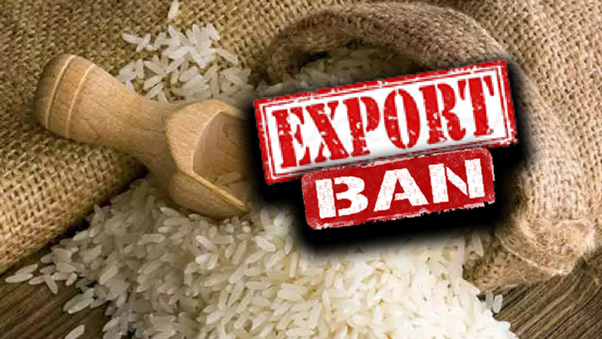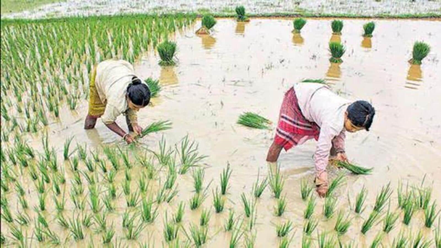Policy to what end, at whose cost
Restricting agri-exports limits gains in global markets, prioritises domestic consumers over farmers
Relevance
- GS Paper 3 Major crops and cropping pattern.
- Issues related to direct and indirect farm subsidies and MSP.
- Tags: #exportban #agriculture #MSP #basmati #currentaffairs #upsc
Why in the News?
The complex dynamics between managing food inflation, agricultural exports, and domestic market priorities form the crux of contemporary policy-making, particularly in light of impending state elections. While curbing inflation is a clear governmental objective, the strategies employed and their resultant impacts on various stakeholders demand careful examination for informed policy formulation.
Restrictions on Basmati Rice Exports: A Case Study
- The imposition of a minimum export price (MEP) of $1,200/tonne on basmati rice stands as a pivotal example. With India historically exporting around 4.5 million tonnes annually, primarily to elite domestic consumers and various international markets, the elevated MEP has severely constrained exports.
- The repercussions are keenly felt in Punjab and Haryana, the primary basmati rice-producing regions, where farmers are experiencing diminished earnings due to restricted trade. Conversely, the urban upper-income class benefits, but at the cost of the rural agrarian community.
- The inadvertent consequence of this policy move is the potential loss of export markets to Pakistan, the main competitor in basmati rice trade. The urgent need to reevaluate this policy, potentially resetting the MEP within the $800 to $850/tonne range, becomes apparent to maintain competitiveness and support farmers’ interests.
Broadened Restrictions on Agri-Exports: Impact and Implications
- The restrictive export policies extend beyond basmati rice, affecting a range of other rice varieties. Non-basmati white rice, broken rice, and parboiled rice face either complete export bans or increased export duties, destabilizing trade. India’s standing as the world’s largest rice exporter (contributing 40 percent of global exports) adds weight to the consequences of such policy shifts.
- For instance, the ban on non-basmati white rice exports triggered alarm in several African countries, tarnishing India’s reputation as a leader in the Global South.
Balancing Domestic Priorities and Agricultural Competitiveness
- The policy orientation to prioritize domestic consumers over the agricultural export sector appears to undermine India’s potential growth in agri-exports.
- The failure to sustain the growth trajectory seen during the UPA government’s tenure highlights a distinct shift.
- The restrictive policies favoring domestic consumers inadvertently impose a significant “implicit tax” on farmers, affecting their livelihoods.
- Addressing domestic needs should involve targeted income policies focusing on the vulnerable sections of society, especially with considerable poverty prevalence.
- This perspective raises questions about the rationale behind imposing high MEPs and jeopardizing hard-earned market positions in favor of Pakistan.
Optimizing Agricultural Competitiveness: The Imperative for R&D and Investments
- Competitiveness in agriculture depends on enhancing productivity through strategic investments in research and development (R&D), seeds, irrigation, and improved farming practices.
- However, India’s current allocation for agricultural R&D, constituting a mere 0.5 percent of the agri-GDP, appears insufficient. Doubling or tripling this investment is essential to bolster India’s agricultural prowess and export capabilities.
- The scenario is further complicated by populist measures, leading to extensive subsidies, loan waivers, and other such measures aimed at wooing voters during election seasons. The misallocation of resources hampers the agricultural sector’s health and its capacity to innovate and compete on a global scale.
Crafting Sustainable Policy for Agricultural Growth
- A nation’s strength lies in its ability to innovate, produce efficiently, and competitively engage in global trade.
- India’s capacity to rise to this challenge hinges on the balance between populism-driven policies and strategic, well-designed agricultural trade policies.
- A reevaluation of export policies, aligned with fostering agricultural competitiveness while catering to domestic needs through targeted interventions, stands as the need of the hour.
Through a concerted effort to optimize agricultural competitiveness and enhance export potential, India can secure its place as a powerhouse in agricultural production and international trade. The pivotal question remains: can India meet this challenge effectively and sustainably?
|
Alternative to export ban, Minimum Export Price (MEP) About MEP is a government policy tool that sets a floor price for the export of specific commodities. It safeguards the domestic market from price fluctuations and supply shortages, addressing concerns about domestic availability, food security, and price stability. Objectives 1. Price Stability: Prevents excessive exports to maintain domestic market stability, averting scarcity and price spikes caused by global market fluctuations or aggressive trade practices. 2. Domestic Food Security: Ensures a consistent supply of essential commodities, especially during high-demand periods or production disruptions, reducing the risk of food shortages. 3. Protecting Farmers: Offers a safety net by preventing international prices from falling too low, guaranteeing fair compensation to farmers and sustaining the agricultural sector. 4. Inflation Control: Maintains stable essential commodity prices, contributing to overall inflation control and a balanced macroeconomic environment. Key Features 1. Price Floor: Establishes a minimum price for exports to prevent dumping at extremely low prices, benefiting both domestic markets and local producers. 2. Export Control: Regulates export quantities, preventing excessive outflows that could lead to domestic shortages or price spikes. 3. Commodity Specific: Tailored to specific products or categories important for domestic consumption, strategic reasons, or national industries. 4. Periodic Review: Subject to regular assessments and adjustments based on international market trends, domestic production, and demand-supply dynamics, ensuring continued effectiveness. |
|
Rice Cultivation
|
Sources: Indian Express
Mains Question
Discuss the repercussions of restrictive measures on agricultural exports, particularly focusing on the case of basmati rice and other agricultural produce. Highlight the trade-offs between prioritizing domestic consumers and bolstering global competitiveness in agri-exports.





